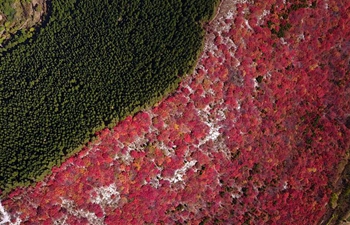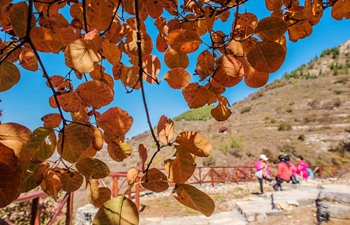by Xinhua writers Luan Xiang, Yuan Quan
BEIJING, Oct. 27 (Xinhua) -- The snow leopard (Panthera uncia), one of the world's most mysterious big cats, is native to the snow-capped mountains in central and southern Asia, inhabiting the Himalayas for 2 million years as a top predator.
Around 60 percent of its natural habitat lies in China, where concerted efforts have been dedicated to protecting the species, which is vulnerable to climate change, habitat loss and human activities such as poaching, according to a report released on the International Snow Leopard Day on Oct. 23.
The big cat's guardians in China are planning to conduct a large-scale survey to figure out the statistical population of the so-called "King of the Snowy Mountains" in the country by 2023.
A FIVE-YEAR PLAN
"We propose to survey at least 340,000 square km or 20 percent of the snow leopard's total habitat within the next five years," said Liang Xuchang, director of the Guangzhou Yuanwang Wildlife Rescue and Service Center.
With data collected by 2023, it could be possible to estimate the total population of snow leopards in China, he told the audience at the report release in Beijing. The assessed area so far covers a mere 1.7 percent of the snow leopard's habitat in China.
The report titled "Status of Snow Leopard Survey and Conservation, China 2018", which compiles 57 studies and conservancy work done in China between 1980 and 2018, was jointly released by 19 research institutes and non-profit organizations.
All are members of China's Snow Leopard Network, a platform aiming to promote joint efforts in safeguarding snow leopards and all species in the Himalayan region.
The report suggested that greater financial aid and manpower should be invested into protecting the species considered emblematic and a major indicator of the highland's eco-balance.
It also called for government efforts in strengthening the monitoring of protected areas and raising public awareness to better protect the animal at the top of the alpine food chain.
Weak protection by local governments, climate change and lack of community support are the main threats that snow leopards are facing, followed by poaching, habitat fragmentation and human activities, warned Xiao Lingyun, a post-doctoral researcher with Peking University.
With the proper technology and diligent practices, snow leopards are likely to become another successful example of China's efforts in preserving wildlife, Liang said. "In the future, there is hope that China will become a major contributor to the protection of global biodiversity."
CRACKDOWN ON POACHING
In different regions, the risks facing snow leopards vary. For example, in northwest China's Qinghai Province, packs of feral Tibetan mastiffs, abandoned after the collapse of the local breeding business, have become the main threat to snow leopards.
And in neighboring Gansu Province, poaching driven by a notorious fur trade has caused the biggest number of snow leopard deaths alongside other endangered species, according to the "Guardians of the Wild", a group of young volunteers devoted to wildlife investigation, anti-poaching inspection and public education.
In recent years, these "guardians" have been telling stories about the snow leopard caught on infrared cameras, who turned fellow big cats and their neighbors - such as Pallas' cat and the Tibetan sand fox - into internet sensations.
One of the feline superstars on Chinese social network was "May the King", a mature male of large build with a torn ear who had dominated an extensive territory, where he and his two female companions made a lovely family with two young cubs.
But it didn't last. Last summer, the King disappeared from the monitors all of a sudden. He, his queens and his heirs, were never seen again, worrying many who had been following their family life updates.
In March 2018, the forest police in Qinghai's Golmud busted wildlife poachers and traders in the city. Eight suspects from two organized gangs were arrested.
Among the confiscated goods were two dead snow leopards.
The forest police officers had traveled hundreds of km across mountains and through valleys in search of proof, making sure that the suspects were brought to justice.
The snow leopard is a Class-A protected animal in China and the International Union for Conservation of Nature classified it as endangered-to-vulnerable last year. China's Penal Code stipulates up to 10 years of imprisonment and property forfeited for those convicted of grave crimes against such rare species.
China has been continuously strengthening wildlife protection efforts in recent years, commented Fan Zhiyong, chief science officer of the World Wildlife Fund in China.
Fighting wildlife trafficking has been listed as a priority within the country's 13th Five-Year Plan, while the building of ecological civilization has become a national strategy. Furthermore, China revised and implemented a new Wildlife Protection Law that entered into force last year.
Chinese customs have carried out a number of nationwide operations while organizing and participating in regional and international collaborative missions.
During this year's operation, titled "Sword at the Country's Gate 2018", illicit wildlife trade was tackled from northeast China's Heilongjiang to south China's Guangxi, with numerous suspects arrested and taken to court.
In the meantime, the national forestry and 21 other departments have set up an inter-ministerial conference system to combat wildlife trafficking and to further improve law enforcement coordination to keep poachers at bay.
In the future, China expects to expand inspections of suitable snow leopard habitats and to strengthen international cooperation against poaching and wildlife trafficking, said Professor Lyu Zhi with Peking University's Nature and Society Research Center.
In September, at the International Snow Leopard Protection Conference held in south China's Shenzhen, the "International Snow Leopard Protection Shenzhen Consensus" was issued, with delegates promising to better coordinate global exchanges related to research on and protection of the species.
Earlier this year, an overall plan for China's first national park, the Sanjiangyuan National Park, located on the Qinghai-Tibet Plateau, was released.
The National Park will prioritize the protection and restoration of the natural environment where the snow leopard is expected to be better looked after, said Ren Zhengde, deputy director of the National Park's administration, at the report release on Tuesday.
NEW WAYS TO PROTECT THE BIG CAT
Earlier this year, a heartbreaking image of a snow leopard sitting in a pile of plastic waste went viral. Many saw it as a sign of pervasive, irresponsible human behavior affecting wildlife, even in the so-called "last pure land on Earth," as well as a wake-up call for the need for immediate action.
The waste problem is a global issue that poses threats to the environment, other species as well as humans. Snow leopards shouldn't have to deal with our garbage, Shashanka Nanda, an Indian photographer who captured the image, told Xinhua via email.
In September, over 1 million people in China were mobilized to clean up trash across the country in celebration of World Cleanup Day. The Guardians of the Wild were among the 700-plus NGOs that organized cleanup activities. Volunteers even trekked across the alpine ranges to clear nondegradable waste.
"On several occasions we have worked with other institutions to tackle plastic waste throughout the snow leopard's habitat," Huang Yahui, co-founder of the Guardians of the Wild, who has insisted that protecting natural habitats is the key to species conservation.
In addition, to maintain the number of indigenous herbivores such as the bharal (blue naur) or alpine ibex is also of vital importance to the predator's survival.
For those who don't have the proper training or time to go on excursions and field studies in the wild, protecting snow leopards can be achieved in different ways.
On Tuesday, a series of artisan beer was launched in support of the cause by the Beijing Home-brewing Society, which promised to donate all profits to research and conservation projects for the big cat.
Japanese artist Mitsuji Kamata imagines the King of the Himalayas to be a top-hat-wearing, rifle-holding gallant feline. This summer, he joined hands with China's action figure-maker Manas Models to create a limited edition of the "Steampunk Snow Leopard" and donate all revenue to the Guardians of the Wild.
The public can also support the cause by buying artwork, beverages and local produce from the habitat, according to Huang.
"It is to our surprise and joy that caring for snow leopards as a 'cloud pet' has become the latest trend and a new hobby for many people," said a team leader at the NGO.

















